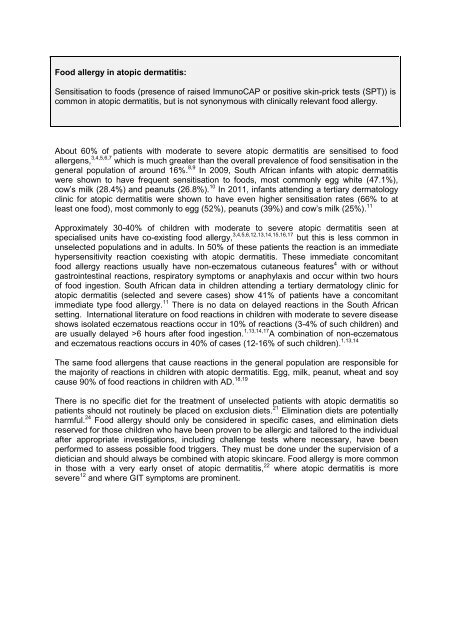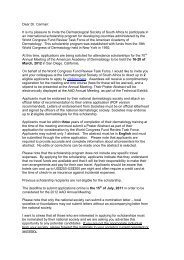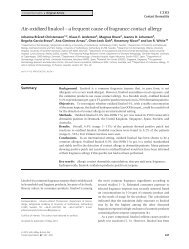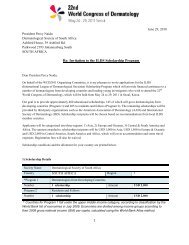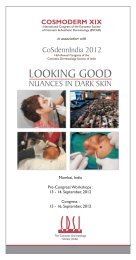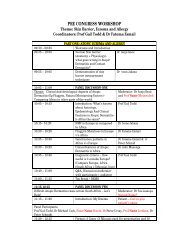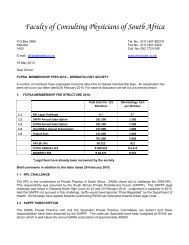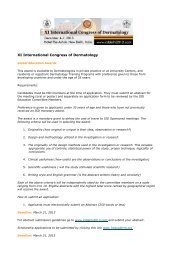Guidelines on the Management of Atopic Dermatitis ... - Dermatology
Guidelines on the Management of Atopic Dermatitis ... - Dermatology
Guidelines on the Management of Atopic Dermatitis ... - Dermatology
Create successful ePaper yourself
Turn your PDF publications into a flip-book with our unique Google optimized e-Paper software.
Food allergy in atopic dermatitis:<br />
Sensitisati<strong>on</strong> to foods (presence <strong>of</strong> raised ImmunoCAP or positive skin-prick tests (SPT)) is<br />
comm<strong>on</strong> in atopic dermatitis, but is not syn<strong>on</strong>ymous with clinically relevant food allergy.<br />
About 60% <strong>of</strong> patients with moderate to severe atopic dermatitis are sensitised to food<br />
allergens, 3,4,5,6,7 which is much greater than <strong>the</strong> overall prevalence <strong>of</strong> food sensitisati<strong>on</strong> in <strong>the</strong><br />
general populati<strong>on</strong> <strong>of</strong> around 16%. 8,9 In 2009, South African infants with atopic dermatitis<br />
were shown to have frequent sensitisati<strong>on</strong> to foods, most comm<strong>on</strong>ly egg white (47.1%),<br />
cow‟s milk (28.4%) and peanuts (26.8%). 10 In 2011, infants attending a tertiary dermatology<br />
clinic for atopic dermatitis were shown to have even higher sensitisati<strong>on</strong> rates (66% to at<br />
least <strong>on</strong>e food), most comm<strong>on</strong>ly to egg (52%), peanuts (39%) and cow‟s milk (25%). 11<br />
Approximately 30-40% <strong>of</strong> children with moderate to severe atopic dermatitis seen at<br />
specialised units have co-existing food allergy, 3,4,5,6,12,13,14,15,16,17 but this is less comm<strong>on</strong> in<br />
unselected populati<strong>on</strong>s and in adults. In 50% <strong>of</strong> <strong>the</strong>se patients <strong>the</strong> reacti<strong>on</strong> is an immediate<br />
hypersensitivity reacti<strong>on</strong> coexisting with atopic dermatitis. These immediate c<strong>on</strong>comitant<br />
food allergy reacti<strong>on</strong>s usually have n<strong>on</strong>-eczematous cutaneous features 4 with or without<br />
gastrointestinal reacti<strong>on</strong>s, respiratory symptoms or anaphylaxis and occur within two hours<br />
<strong>of</strong> food ingesti<strong>on</strong>. South African data in children attending a tertiary dermatology clinic for<br />
atopic dermatitis (selected and severe cases) show 41% <strong>of</strong> patients have a c<strong>on</strong>comitant<br />
immediate type food allergy. 11 There is no data <strong>on</strong> delayed reacti<strong>on</strong>s in <strong>the</strong> South African<br />
setting. Internati<strong>on</strong>al literature <strong>on</strong> food reacti<strong>on</strong>s in children with moderate to severe disease<br />
shows isolated eczematous reacti<strong>on</strong>s occur in 10% <strong>of</strong> reacti<strong>on</strong>s (3-4% <strong>of</strong> such children) and<br />
are usually delayed >6 hours after food ingesti<strong>on</strong>. 1,13,14,17 A combinati<strong>on</strong> <strong>of</strong> n<strong>on</strong>-eczematous<br />
and eczematous reacti<strong>on</strong>s occurs in 40% <strong>of</strong> cases (12-16% <strong>of</strong> such children). 1,13,14<br />
The same food allergens that cause reacti<strong>on</strong>s in <strong>the</strong> general populati<strong>on</strong> are resp<strong>on</strong>sible for<br />
<strong>the</strong> majority <strong>of</strong> reacti<strong>on</strong>s in children with atopic dermatitis. Egg, milk, peanut, wheat and soy<br />
cause 90% <strong>of</strong> food reacti<strong>on</strong>s in children with AD. 18,19<br />
There is no specific diet for <strong>the</strong> treatment <strong>of</strong> unselected patients with atopic dermatitis so<br />
patients should not routinely be placed <strong>on</strong> exclusi<strong>on</strong> diets. 21 Eliminati<strong>on</strong> diets are potentially<br />
harmful. 24 Food allergy should <strong>on</strong>ly be c<strong>on</strong>sidered in specific cases, and eliminati<strong>on</strong> diets<br />
reserved for those children who have been proven to be allergic and tailored to <strong>the</strong> individual<br />
after appropriate investigati<strong>on</strong>s, including challenge tests where necessary, have been<br />
performed to assess possible food triggers. They must be d<strong>on</strong>e under <strong>the</strong> supervisi<strong>on</strong> <strong>of</strong> a<br />
dietician and should always be combined with atopic skincare. Food allergy is more comm<strong>on</strong><br />
in those with a very early <strong>on</strong>set <strong>of</strong> atopic dermatitis, 22 where atopic dermatitis is more<br />
severe 12 and where GIT symptoms are prominent.


